If you work with Agile teams, you’ve probably noticed that everyone seems to follow their own version of “Agile.”
It is difficult to scale agile in large organizations, and that’s where PI planning turns out to be important in the Scaled Agile Framework (SAFe) for coordinating across multiple teams. It also helps define clear objectives, better align teams, and ensure consistent value delivery. In this article, however, we will decipher PI planning, a vital strategic event that perfectly aligns with the principles of the Agile manifesto.
What is PI Planning?
PI (Program Increment) planning is a virtual or in-person face-to-face meeting of agile teams to review the backlogs and plan the upcoming program increment within the Scaled Agile Framework (SAFe).
A Program Increment refers to a set period of time during which a group of agile teams, also known as Agile Release Train (ART), work collaboratively on delivering the defined value proposition.
You can think of Program Increment as a long-term sprint, where it’s not just your team working on improving website navigation, but the whole Agile Release Train (ART) is working collaboratively on project-level deliverables such as search functionality and overall design consistency, in addition to the improved navigation.
Program Increment planning is a repetitive process that occurs every 8-12 weeks, depending on the length of the PI. ART reviews the previous PI and, if required, adapts to the changes by addressing and re-establishing the dependencies.
PI planning might not seem important initially; however, it is key to strike a balance between structured planning for alignment and the flexibility to adapt to change in Agile development.
PI planning falls primarily under the Scaled Agile Framework (SAFe) of software development, where you scale the agile methodologies to incorporate the complexities associated with large-scale projects.
A Free guide to help you with proven ways to lead a project from start to finish, without confusion or jargon.

Why is PI planning important in SAFe?
Large-scale projects are inherently complex, demanding more than just weekly meetings and retrospectives for effective project management.
Here is why PI planning is vital in the Scaled Agile Framework (SAFe):
- Enhance transparency across the Agile Release Train (ART): It ensures that all the teams and stakeholders have a clear vision of the roadmap, team plan, and other business objectives.
- Manage dependencies across multiple teams: Effective dependency management helps in reducing risks, smooth collaboration, and delivering value efficiently.
- Provide clarity on business priorities and objectives: It ensures clear communication regarding the objectives and priorities to the team so that the most valuable features and initiatives receive priority.
- Support continuous improvement through retrospectives: It helps teams to learn from past experiences, such as what worked and what did not, so they can improve future planning and execution.
- Improves predictability by committing to realistic objectives: It minimizes unexpected roadblocks by identifying early dependencies, which results in better forecasting and reliable delivery.
In contrast, a lack of well-executed PI planning may cause functional silos to creep in and create a major obstacle to effective execution.
For instance, your design team might work on the user interface independently, while the backend team focuses solely on data integration. As the project progresses, the user interface elements don’t fit well with the data flow, leading to glitches and user experience issues.
Now, that’s just one situation PI planning helps the ART avoid. The following is a comprehensive list of benefits PI brings to the Scaled Agile Framework (SAFe).
What are the benefits of well-executed PI planning?
- Value stream alignment: SAFe relies heavily on development and business stakeholders working together. PI planning provides a platform for business planners and development teams to find a middle ground for the most effective business growth. It helps to prioritize work, align scopes, and create the most effective product roadmap.
- Risk mitigation: PI planning involves team members coming from diverse backgrounds, including business, technical, and operational. Providing better insights from both technical and business perspectives, thereby enabling more effective contingency planning.
- Enhanced visibility: With everyone in the Agile Release Train (ART) having a clear understanding of what they need to do and how their work may impact the overall progress of the project, ensures a streamlined execution of tasks and flexibility to adapt to dynamic changes.
- Delivery predictability: As mentioned earlier, business teams rely heavily on development teams to formulate business plans and outcomes under SAFe. PI planning allows development teams and business teams to collaborate and define mutually agreeable and realistic PI objectives. A common method is to design the objectives under SMART criteria. This way, there is less confusion and a better predictability of delivery.
- Improved collaboration: Collaboration is an essential part of any project’s success. This importance amplifies even more when you are working with diverse teams, not just individuals. PI planning plays an important role in bringing together cross-functional teams. Additionally, a coordinated effort of all stakeholders, including teams, product owners, managers, and other relevant parties, ensures better execution and fewer surprises.
- Better utilization of resources: The PI planning process ensures teams are working on the right priorities. It prevents bottlenecks and overburdening for teams by identifying dependencies early. The method also improves productivity by providing the right task to the right people, which helps with better resource utilization.
- Speeds up decision-making: Bringing all the team members from different backgrounds to the same table not only mitigates risk but also helps in quick decision-making. With such an immense number of experienced team members present during the PI planning, it is easy to find the solution for any challenge hampering productivity and come to a final decision without any obstruction.
Read More: How to effectively establish cross-functional collaboration among your teams
Who should be involved in PI planning?
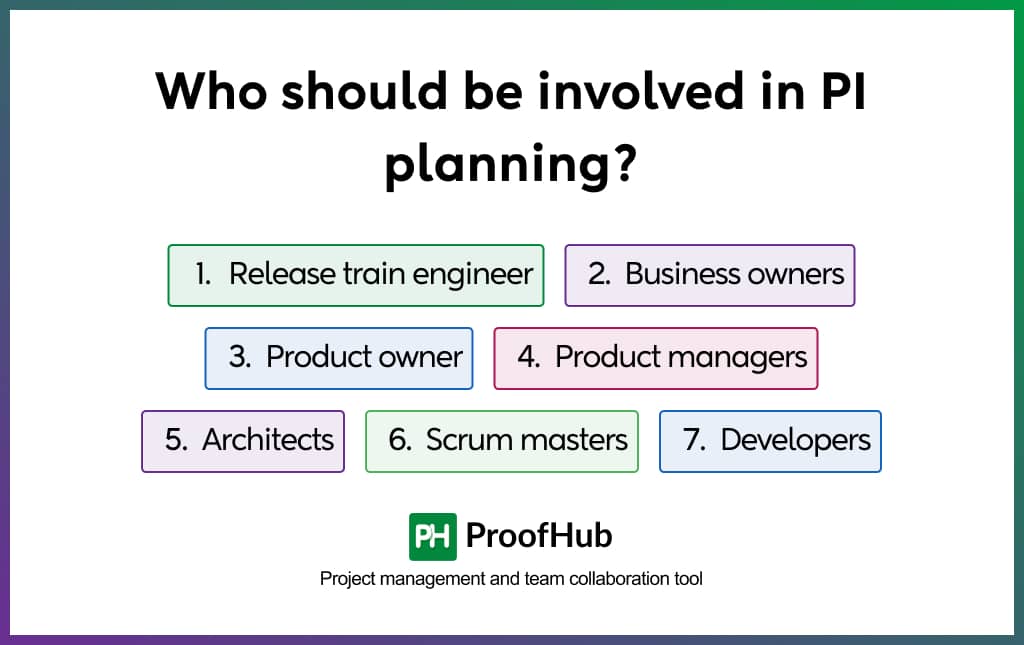
PI planning is a collaborative process and involves individuals from several departments in an organization. Nonetheless, they are primarily designated under the following roles:
- Release Train Engineer: The Release Train Engineer (RTE) oversees the overall PI planning event. The key responsibilities of the RTE are to guide the participants throughout the event, conduct pre- and post-event meetings, and ensure everything runs smoothly.
- Business owners: A business owner describes the business context to the rest of the participants.
- Product Owner: Describes the overall product vision and development priorities.
- Product Managers: Describe the feature vision and prioritize backlog items.
- Architects: System architects and solution architects, offering architectural design insights.
- Scrum Masters: Scrum masters operate at a team level to facilitate PI planning. They assist RTE and ensure everyone on their team is on the same page.
- Developers: Developers are responsible for estimating the work that needs to be done to deliver the features in the upcoming PI.
Read More: Project Manager roles and responsibilities.
PI planning preparation checklist
Program Increment (PI) planning requires planning of its own. Whether you are a seasoned agile practitioner or just starting out, here’s a handy checklist to guide you through the “planning” for a PI planning event.
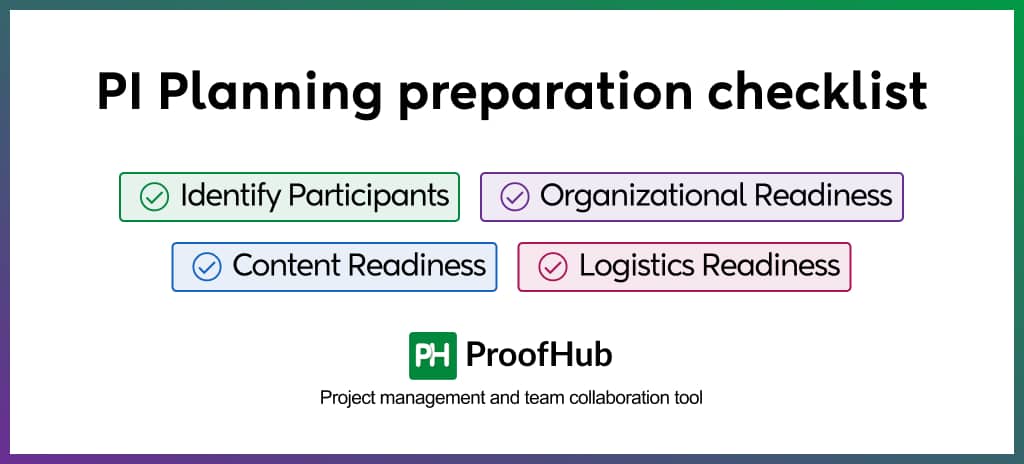
1. Identify participants
The first step is to assemble the right Agile Release Train (ART) members, depending on the scope of your project. This includes assigning roles to participants, such as the Release Train Engineer (RTE) to facilitate the event, business owners to guide business priorities, product managers to present feature vision, system architects to provide architectural insights, etc.
2. Organizational readiness
Next, RTE needs to ensure that strategic alignment exists among participants and stakeholders. Confirm the scope, priorities, and roles, and validate that agile teams have designated members, Scrum Masters, and Product Owners.
3. Content readiness
Prepare essential briefings, including an executive-level context briefing, product vision presentations, and architectural insights. These briefings provide a clear understanding of the current state, future goals, and technical direction.
4. Logistics readiness
If the event is virtual, ensure the technical infrastructure is in place for remote participation. Set up communication tools, audio, video, and collaboration platforms for real-time feedback sharing.
Step-by-step PI planning agenda
PI planning events follow a standard agenda to ensure consistency, alignment, and effective communication among Agile Release Trains (ARTs). Usually, the agenda is planned for two days, which can be tweaked to create a split agenda of 2.5 days to coincide with members located across different time zones.
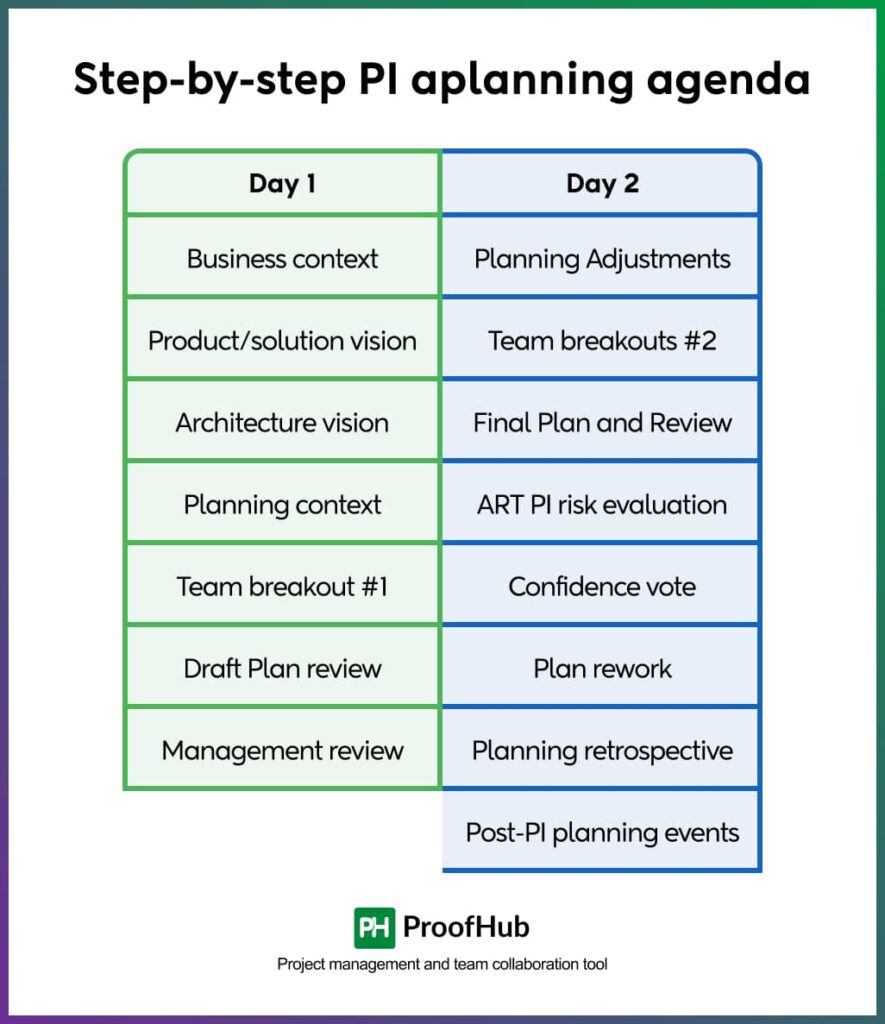
Day 1
1. Business context
Day 1 kicks off with senior executives and business owners setting up the business context, where they reflect on the current state of the business and consumers’ take on the previous PI.
2. Product/solution vision
Product owners and managers present the vision for upcoming features and changes in the previous PI.
3. Architecture vision and development practices
System and solution architects discuss the architectural vision and changes that teams will adopt in the upcoming PI.
4. Planning context
RTE (Release Train Engineer) sets the stage and explains the planning process and outcomes.
5. Team breakout #1
The breakout session is for teams to decide on their capacity planning, identify backlogs, risks, and dependencies, and prepare an initial PI objective.
Team members segregate these objectives into committed and uncommitted objectives based on the risk and uncertainty associated with each one.
6. Draft Plan review
During the draft plan review, business owners, stakeholders, and other management review the initial drafts that include the PI objective, capacity & load, risks, and dependencies.
7. Management review and problem-solving
The draft plan usually includes some challenges like resource constraints, scopes, and dependencies. Management and team members then negotiate to find a middle ground for aligning the scope with achievable objectives.
Day 2
1. Planning Adjustments
Day 2 begins with management adjusting the planning scope, people, and resources. Every planning adjustment should be posted on the program board to keep all members informed.
2. Team breakouts #2
The team continues to plan and present business owners with adjusted PI objectives, to which business owners assign business values as prioritization scores.
3. Final Plan and Review
During this session, all teams present their final plan, with all the potential risks and impediments, to the group. If all the business owners agree to the final plan, the PI objectives are shared with everyone.
4. ART PI risk evaluation
All the identified risks and impediments in the previous session are evaluated by the Agile Release Trains (ARTs) under the ROAM framework.
- Resolved: Teams agree that risk is no longer a concern.
- Owned: The risk can’t be resolved during PI planning, so one of the team members takes ownership to eliminate the risk later.
- Accepted: The risk must be accepted as it is, since there is no workaround.
- Mitigated: Teams identify a workaround plan for the risk.
5. Confidence vote
A confidence vote ceremony is conducted to make sure that attendees are in alignment with PI objectives and agree that the plan is achievable. Attendees cast votes with the show of fingers, or digital counters if the PI planning event is online. If the average count is above three, the plan is green-flagged for a go. If not, the plan is reworked.
6. Plan rework
The plans with low confidence are reworked until agreed upon by everyone.
7. Planning retrospective and moving forward
Finally, the RTE runs a retrospective where they reflect on what went well during the PI planning event, what didn’t, and what could be done better.
8. Post-PI planning events
After the planning event, RTE and other ART stakeholders will write down and communicate the PI objectives to other team members in the ART. The product management breaks down and distributes the tasks among the team members and prepares a roadmap outline for individual teams. Additionally, teams also decide on the timeframe for Innovation and Planning (IP) iteration during the next PI.
What are the common challenges in PI planning?
PI planning is an extensive event with a tightly packed schedule for many things to include. Surely, things are not going to go exactly as planned. Nonetheless, here are some pitfalls that are completely avoidable with a little effort.
1. Lack of planning
PI planning requires planning. Though the event unfolds according to a standard agenda every time, neglecting to map out the event structure, role allocation, and providing necessary briefings to the attendees can cause serious disarray and confusion during the event.
2. Lack of prioritization in your agenda
Since all the individual events in your PI planning are time-boxed, it is important to prioritize the time allocation accordingly. For instance, allocating too much time for events that do not directly contribute to the PI objectives, risk identification, or plan refinement, may force you to make hasty decisions in the planning process.
3. Running long-boring sessions
You don’t want a PI planning event to be a long presentation given by leaders, just to be preached by the teams. Given the time constraints, it is important for your agenda items to be short and straightforward, leaving more room for actual planning. Additionally, every session should be engaging to keep the participants invested and bring the best out of each other.
4. Missing out on retrospective insights
Neglecting the insights from previous PI can lead to repeated mistakes and stagnation. Retrospectives are the goldmines for teams to make well-informed decisions. It becomes easier for teams to identify the areas where they are overcommitting or underperforming based on historical data. Encouraging team members to talk about what worked and what didn’t provides you with tested and proven information that you can integrate into your planning process for better results.
5. Ignoring technical debt
Technical debt refers to the accumulated cost of undone development work, shortcuts, code patches, and other suboptimal coding practices that compromise the quality of your product. Failing to address these issues in the PI planning process can cost teams the flexibility to adapt to new changes quickly. By deliberately addressing these issues head-on in the PI planning process, teams can allocate time for cleanup and mitigation.
Read More: 15 most common Project management challenges (and solutions)
PI planning vs. Sprint planning
PI planning and sprint planning are both planning processes that agile teams rely on to get things done. Nonetheless, they are quite different in terms of scale and context.
Timeframe
Sprint planning is done by development teams to map out the tasks they need to complete within the next sprint, a time-boxed period usually lasting 1-4 weeks.
PI planning entails planning objectives for the next program increment, a project phase that usually lasts 8-12 weeks.
Scope
Sprint planning involves selecting an item from the product backlog, estimating the effort required, and creating a plan to deliver that item within a sprint.
PI planning has a more comprehensive scope than sprint planning. It includes defining objectives for the next program increment, evaluating the risks associated, and establishing cross-departmental dependencies for streamlining the progress.
Objectives
The primary objective of sprint planning is effective workload distribution and resource allocation for the on-time delivery of the user story.
PI planning involves a more holistic approach to overall business growth. The primary objective of PI planning is to align the scope of all the teams in the ART with business objectives. This requires input from several participants, such as business owners, product owners, development teams, etc.
PI planning vs. Big room planning
PI planning is a type of Big Room planning specifically for the Scaled Agile Framework (SAFe).
Here is a comparison table of both:
| Features | PI Planning | Big Room Planning |
| Framework | Scaled Agile Framework (SAFe) | Not specific to any framework and can be used at any Agile at-scale setup |
| Frequency | After every Program Increment (8-12 weeks) | Depends on project needs. Usually, happens quarterly |
| Focus | Planning for the next Program Increment only | Broader planning for larger projects |
| Structure | 2-day agenda with structured activities | Flexible and varies based on the organization |
| Goal | Set clear goals for the next program increment, clear backlogs, and identify dependencies | Align team on shared goals, identify dependencies, and create a high-level plan |
Cut the fluff and get to the stuff. Streamline your planning process with these project planning tools in 2025.
Streamline PI planning process with ProofHub
A project management and team collaboration tool resides at the heart of a PI planning event. In today’s dynamic landscape of teams distributed around the globe, having a centralized platform that seamlessly brings everyone together is a must.
This is where ProofHub comes in. With an array of diverse features, ProofHub is not just a project management and team collaboration tool for agile teams, but also a strategic asset for orchestrating effective planning events.
1. Seamless collaboration
PI planning is all about effective communication and collaboration. Teams in the ART need to collaborate, share insights, align their goals, and plan objectives cohesively. With ProofHub, this key aspect is taken care of with an array of features that enable real-time discussions and document sharing, ensuring that every team member is on the same page.
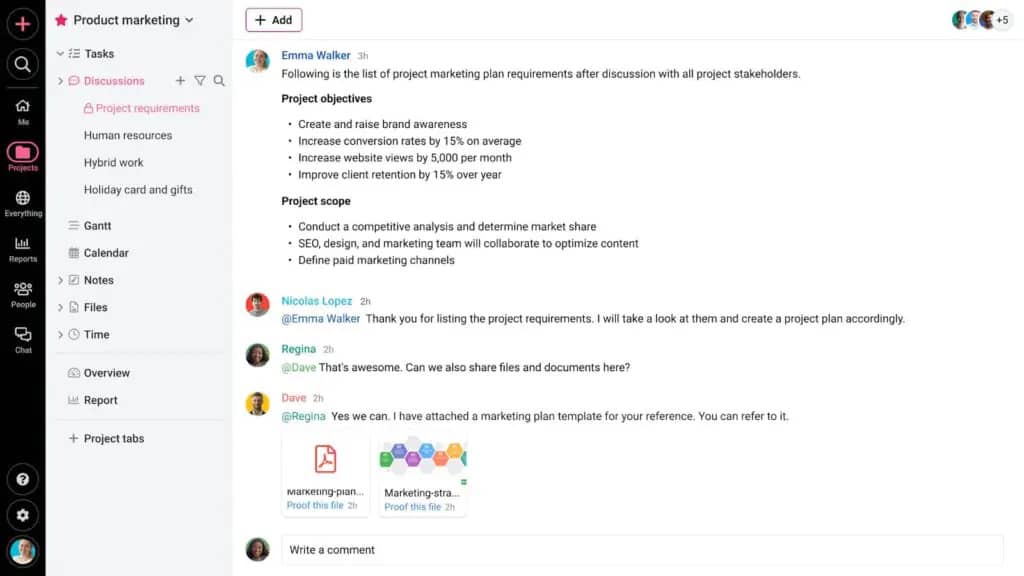
From refining user stories to identifying dependencies, ProofHub’s collaboration capabilities facilitate the seamless flow of information, even when the team members are located miles apart
2. Centralized planning and visibility
PI planning events are always short on time. Juggling spreadsheets, emails, and numerous tools is not the most effective way to manage your PI planning event.
ProofHub provides everything you need under one roof. The centralized platform allows you to create and manage user stories, prioritize tasks, and assign responsibilities.
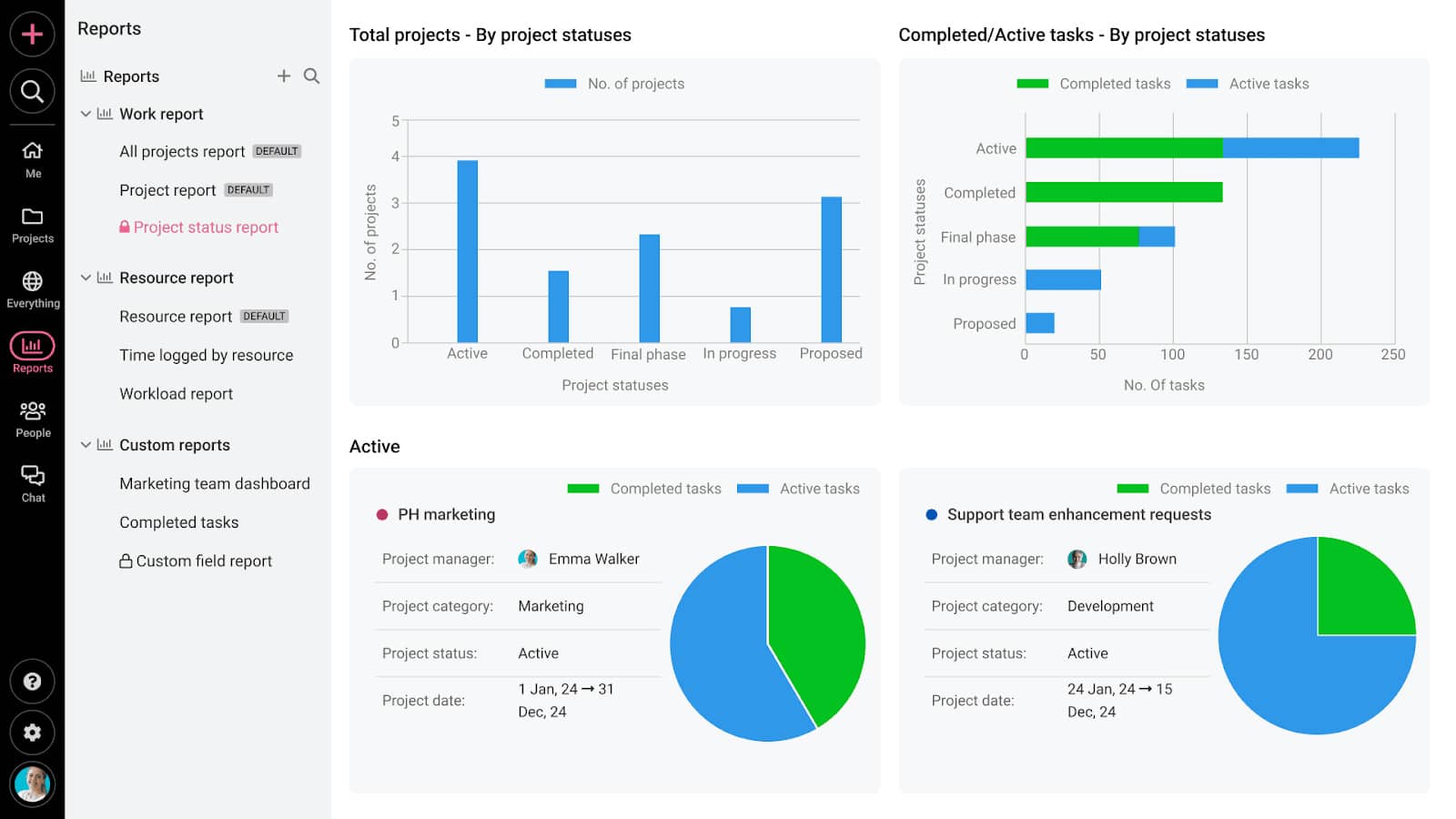
This level of consolidation not only saves time but also provides unparalleled visibility into the planning process. Stakeholders can quickly access timelines, progress charts, and updates, eliminating confusion and ensuring everyone remains aligned with the end business objectives.
3. Risk Mitigation
With ProofHub, you can monitor the progress of events, identify potential delays, and make necessary adjustments on the go. Moreover, ProofHub facilitates risk evaluation and contingency planning through its intuitive interface. You can assess potential bottlenecks with Gantt charts, evaluate risks associated with dependencies by highlighting the critical path, and devise contingency plans to mitigate potential disruptions.
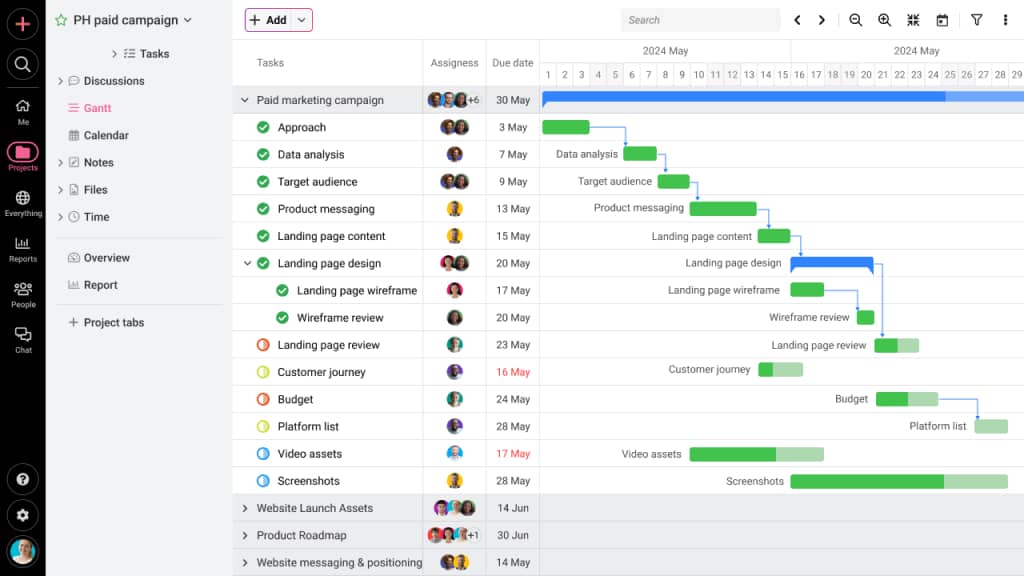
This comprehensive approach to risk management ensures that your PI planning remains flexible.
Conclusion
PI (Program Increment) planning is not just an event where business leaders gather to hash out a schedule for the upcoming development cycle. It’s a dynamic and strategic process that serves as the heartbeat of an Agile organization.
This event manifests the essence of Agile principles, fostering an environment of open communication, transparency, and collective ownership. It’s a time to connect the dots between the overarching business goals and the tangible work that teams will undertake.
Frequently asked questions
Is PI planning a match for Scrum?
PI planning involves teams coming from diverse departments, whereas Scrum is a framework for software development under agile methodology. While technically you can have a two-day planning event for developing the next feature, it does not seem the most effective way to go about it. Sprint planning is beneficial when it comes to Scrum, while PI planning is suitable for the Scaled Agile Framework.
Who is responsible for PI planning?
Program Increment (PI) planning is a collaborative effort of agile teams to ensure the successful delivery of customer value in the next Program Increment. The key roles involved in PI planning include the Release Train Engineer (RTE), Product owners and managers, Scrum Master, System Architects, and other stakeholders.
How long is PI planning in Agile?
PI planning is usually a two-day-long planning event, which can be extended to incorporate the remote teams located in different time zones.
How do I prepare for PI planning?
The pre-planning phase of PI planning primarily includes four readiness aspects: identifying participants, organizational readiness, content readiness, and logistical readiness.
First, identify the participants and assign the roles accordingly.
Next, Product owners ensure that their team’s backlog is refined with well-defined user stories and acceptance criteria. Collaborate with Product Managers to clarify objectives and align priorities. Furthermore, if your organization is hosting an online PI planning event, make sure that teams are equipped with the necessary tools.
Who organizes PI planning?
PI planning is typically organized by the Release Train Engineer (RTE), who is responsible for coordinating and facilitating the PI planning event. They work closely with Product Management, Scrum Masters, Agile teams, and other stakeholders to ensure that the planning process is smooth, well-structured, and aligned with the organization’s goals. The RTE sets the agenda, schedules the event, and guides the participants through the various activities during the planning session.
What are the inputs and outputs of PI planning?
PI planning involves several inputs and outputs that contribute to the successful alignment of agile teams across the ART.
Inputs
- Business context
- Product and architecture vision
- Capacity and velocity
- Customer insights
Outputs
- PI objectives
- Comprehensive risk evaluation
- Dependencies
What tool is used for PI planning?
The tools that are essential for PI planning are:
- A whiteboard tool, like Microsoft Whiteboard, for creating a collaborative program board.
- A project management and team collaboration tool, like ProofHub, for documenting processes, file sharing, real-time communication, and contingency planning.
- A video conferencing tool, like Zoom or Google Meet, for facilitating face-to-face communication.
What is the role of PI planning?
Program Increment planning plays an important role in the Scaled Agile Framework of software development. It provides a platform for the alignment of all the agile teams in the ART with overall business objectives. Additionally, it helps with mapping out and establishing dependencies for streamlined development in the next PI.

